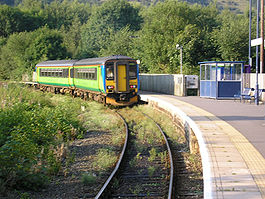Ambergate railway station
| Ambergate |
|
|---|---|

Ambergate station seen in 2005
|
|
| Location | |
| Place | Ambergate |
| Local authority | Borough of Amber Valley |
| Grid reference | SK348516 |
| Operations | |
| Station code | AMB |
| Managed by | East Midlands Trains |
| Number of platforms | 1 |
| DfT category | F2 |
| Live arrivals/departures, station information and onward connections from National Rail Enquiries |
|
| Annual rail passenger usage* | |
| 2011/12 |
|
| 2012/13 |
|
| 2013/14 |
|
| 2014/15 |
|
| 2015/16 |
|
| History | |
| 11 May 1840 | Station opens as Amber Gate |
| 1 October 1846 | Station renamed Ambergate |
| 1 June 1863 | Station moved 400m due south |
| 10 December 1876 | Station moved 605m due north |
| National Rail – UK railway stations | |
| * Annual estimated passenger usage based on sales of tickets in stated financial year(s) which end or originate at Ambergate from Office of Rail and Road statistics. Methodology may vary year on year. | |
|
|
|
Ambergate railway station is a railway station owned by Network Rail and managed by East Midlands Trains (EMT) train operating company (TOC). It serves the village of Ambergate in Derbyshire, England. The station is located on the Derwent Valley Line from Derby to Matlock, which diverges from the Midland Main Line just south of the station at Ambergate Junction.
It has a complicated history. The original station was built for the North Midland Railway in 1840, between Derby and Leeds. It was an ornate building, by Francis Thompson, which would have graced a Lord of the Manor.
From Belper the line ran along the Derwent Valley, along a stretch called Broadholme, with four bridges across the river, through Longlands Tunnel, across the River Derwent and Derby road with a magnificent five-arch viaduct. It then entered Hag Wood Tunnel as turned towards the Amber Valley.
The station building was just north of this tunnel. Shortly afterwards a proposal was made for an Ambergate, Nottingham, Boston and Eastern Junction Railway which however never materialised, apart from a stretch between Colwick and Grantham.
From Ambergate, towards Chesterfield, the next difficulty for the North Midland Railway was the intersection with the Cromford Canal, where the line intersected with the Bullbridge Aqueduct, before it carried on through a station at Wingfield to Stretton.
...
Wikipedia
